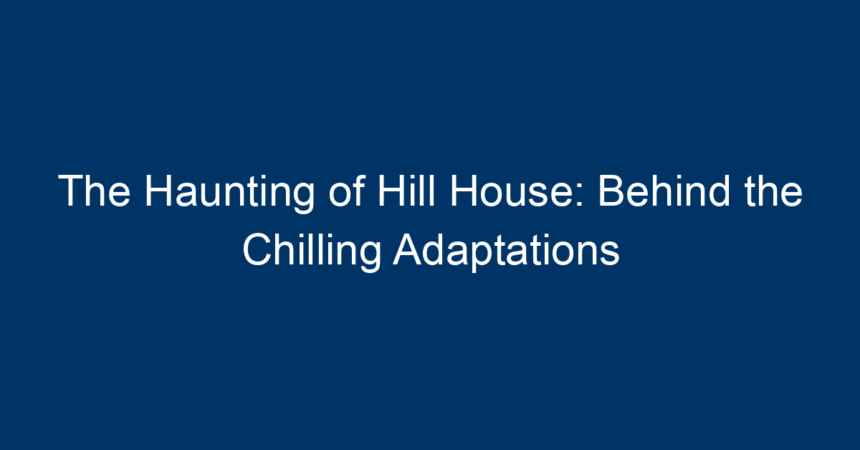Introduction
“The Haunting of Hill House” is more than just a title—it’s an enduring exploration of fear, loss, and the supernatural that has captured the imaginations of readers and viewers alike. Originally penned by Shirley Jackson in 1959, the story has transcended its literary origins, inspiring multiple adaptations in films and television. These adaptations highlight the versatility of Jackson’s narrative, each offering unique interpretations of the story while maintaining the eerie essence that makes it so iconic. In this article, we’ll delve into the haunting legacy of this chilling tale, exploring its adaptations and what makes them resonate with audiences today.
The Origins of The Haunting of Hill House
Shirley Jackson authored "The Haunting of Hill House" during a time when psychological horror was on the rise. The novel is centered around a group of individuals invited to Hill House for a paranormal investigation. What begins as an exploration of the supernatural soon reveals deeper themes of isolation, fear, and the impact of familial relationships. Jackson’s nuanced character development and atmospheric prose have solidified her place as one of the foremost writers of gothic literature.
The Storyline
At its core, the narrative revolves around four main characters: Dr. John Montague, who seeks to conduct research on psychic phenomena; Eleanor Vance, a shy woman who craves acceptance; Theodora, a bohemian artist; and Luke Sanderson, the heir of Hill House. Their experiences within the eerie walls of Hill House delve into the psychological strains of their relationships and the spectral manifestations that disrupt their realities.
The First Adaptation: The Haunting (1963)
The first notable adaptation of Jackson’s work came in 1963 with Robert Wise’s film, “The Haunting.” This adaptation is often celebrated for its minimalist yet chilling approach to horror. Instead of relying on graphic imagery, Wise’s film emphasizes atmosphere, suspense, and psychological tension, allowing the audience to go on a journey of fear and speculation.
Cinematic Techniques
Wise used innovative filming techniques to convey the unsettling nature of the house, including the use of distorted angles and shadows. The haunting score and the ambiguous presence of paranormal activity serve to amplify the underlying dread. Critics regard this film as a classic example of horror that leaves much to the imagination, effectively embodying Jackson’s narrative style.
The Second Adaptation: The Haunting (1999)
Fast forward to 1999, and we find another attempt to bring “The Haunting of Hill House” to the big screen. Directed by Jan De Bont, this version leans heavily on modern special effects and a star-studded cast, including Liam Neeson and Catherine Zeta-Jones. While it was marketed as a horror film for a new generation, it received mixed reviews and is often viewed as less faithful to Jackson’s original work.
Critique and Reception
Critics lambasted the 1999 adaptation for prioritizing visual spectacle over the psychological depth of the characters. While it entertained audiences through thrills and blaring jump scares, many felt it strayed too far from the essence of the novel. The adaptation made clear that sometimes less is indeed more, especially in the genre of horror, where atmosphere often outweighs shock value.
The Most Acclaimed Adaptation: The Haunting of Hill House (2018)
A significant revival of interest in “The Haunting of Hill House” occurred with Netflix’s 2018 series, produced by Mike Flanagan. This adaptation diverged from Jackson’s narrative while preserving its core themes: family, trauma, and the haunting nature of grief.
A Modern Take on a Classic Story
Flanagan’s series reimagined the story in a way that appealed to contemporary audiences. It interlaced the characters’ pasts with their present, creating a rich tapestry that explored the long-lasting impacts of trauma. Each episode unfolded from different perspectives, revealing how the experiences at Hill House shaped the Crain family’s complex dynamics.
Key Themes and Symbolism
The series emphasizes psychological horror more than supernatural frights. It showcases how each character grapples with their trauma, rendering the viewer invested in their journeys. Flanagan adeptly uses symbolism, such as the house itself, to represent not only physical space but also emotional struggles and unresolved pasts.
The Impact of Adaptations on the Original Novel
The adaptations of “The Haunting of Hill House” underline the timeless relevance of Shirley Jackson’s work. Each reinterpretation invites new generations to experience the story, often leading them back to the original novel.
Broader Cultural Influence
The impact of the adaptations extends beyond the screen and into popular culture, influencing other horror narratives and creative works, from literature to television. The Netflix series, for example, sparked discussions about mental health, grief, and the complexity of family relationships, proving that Jackson’s insights remain potent today.
Conclusion: The Enduring Legacy of The Haunting of Hill House
The haunting legacy of “The Haunting of Hill House” stretches across decades, continually adapting to the fears and experiences of modern audiences. From Shirley Jackson’s psychological literary masterpiece to cinematic representations that evoke chills, its rich themes of loss, trauma, and humanity keep it relevant.
Actionable Insights
If you’re intrigued by the evolving landscape of horror storytelling, consider exploring the adaptations of “The Haunting of Hill House.” Here are some actionable insights:
-
Read the Original Novel: Immerse yourself in Jackson’s prose to appreciate the source material before diving into adaptations.
-
Watch the 1963 Film: Experience the film that defined psychological horror for its time, focusing on atmosphere and tension.
-
Engage with the Netflix Series: Discover how modern storytelling can reinterpret classic narratives while addressing contemporary issues.
- Join Discussions: Engage in conversations with others who have experienced the adaptations to gain different perspectives and insights.
By embracing these themes, both new viewers and longtime fans can appreciate the chilling adaptations of “The Haunting of Hill House,” and understand why it continues to haunt us all.




